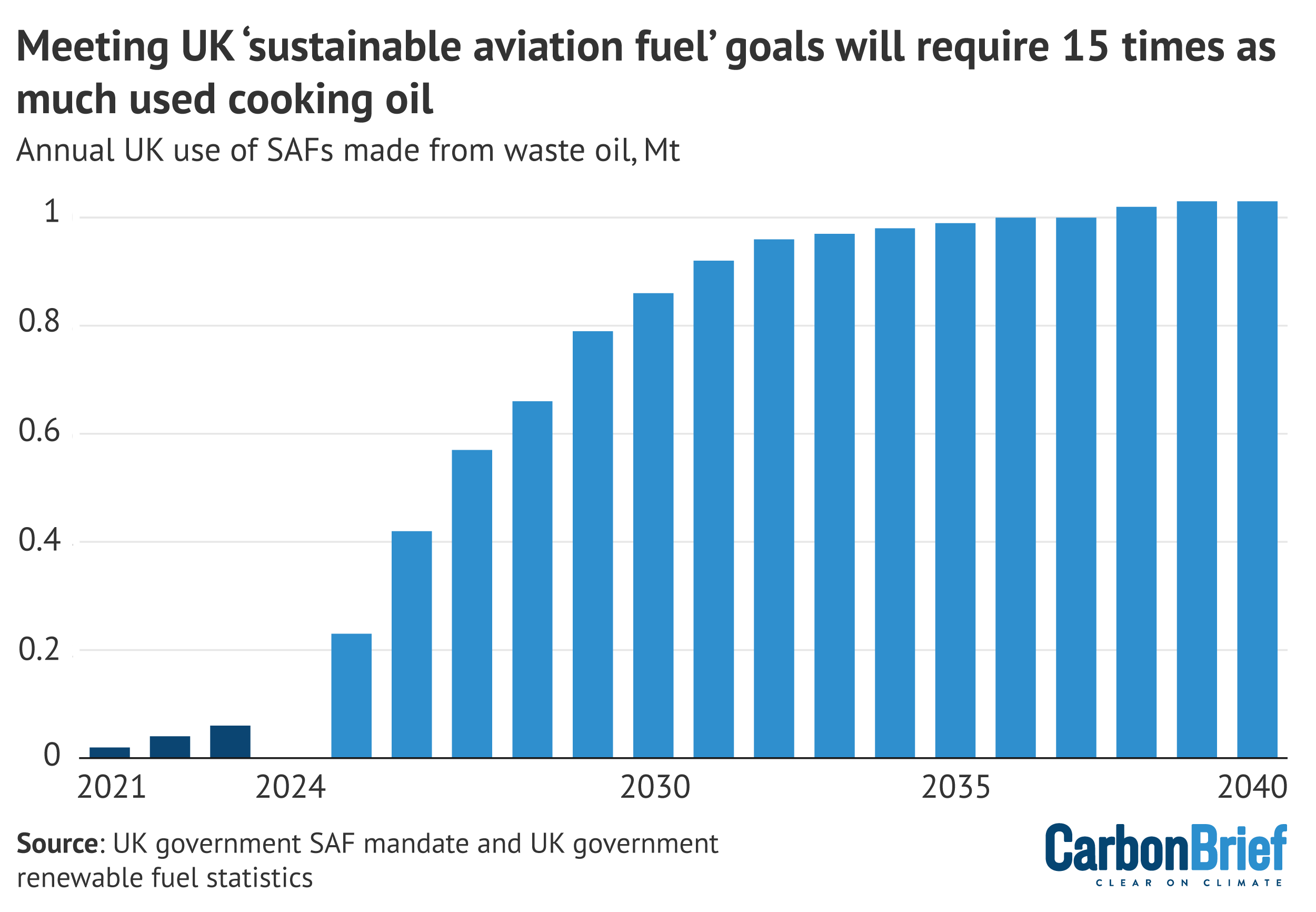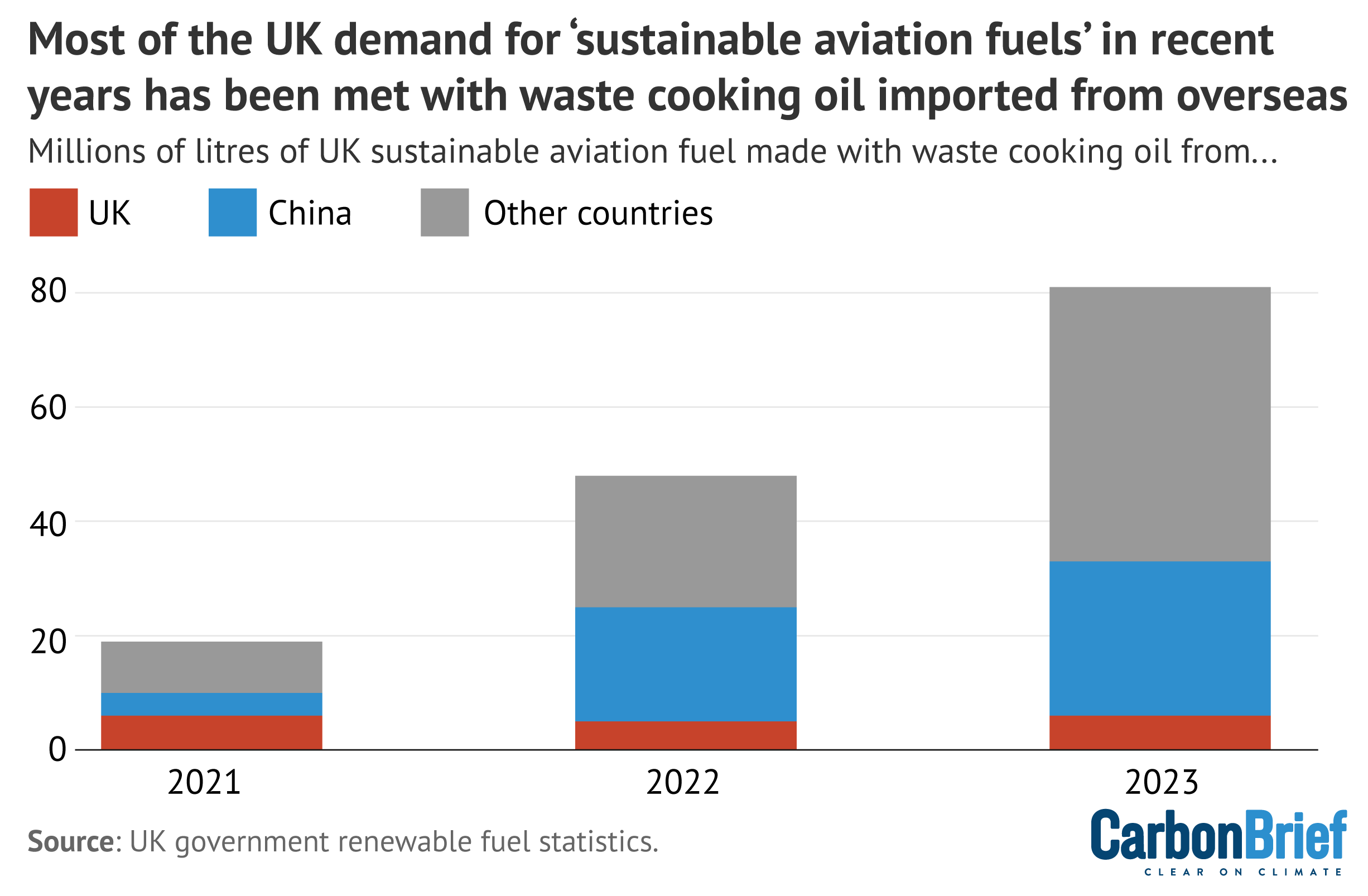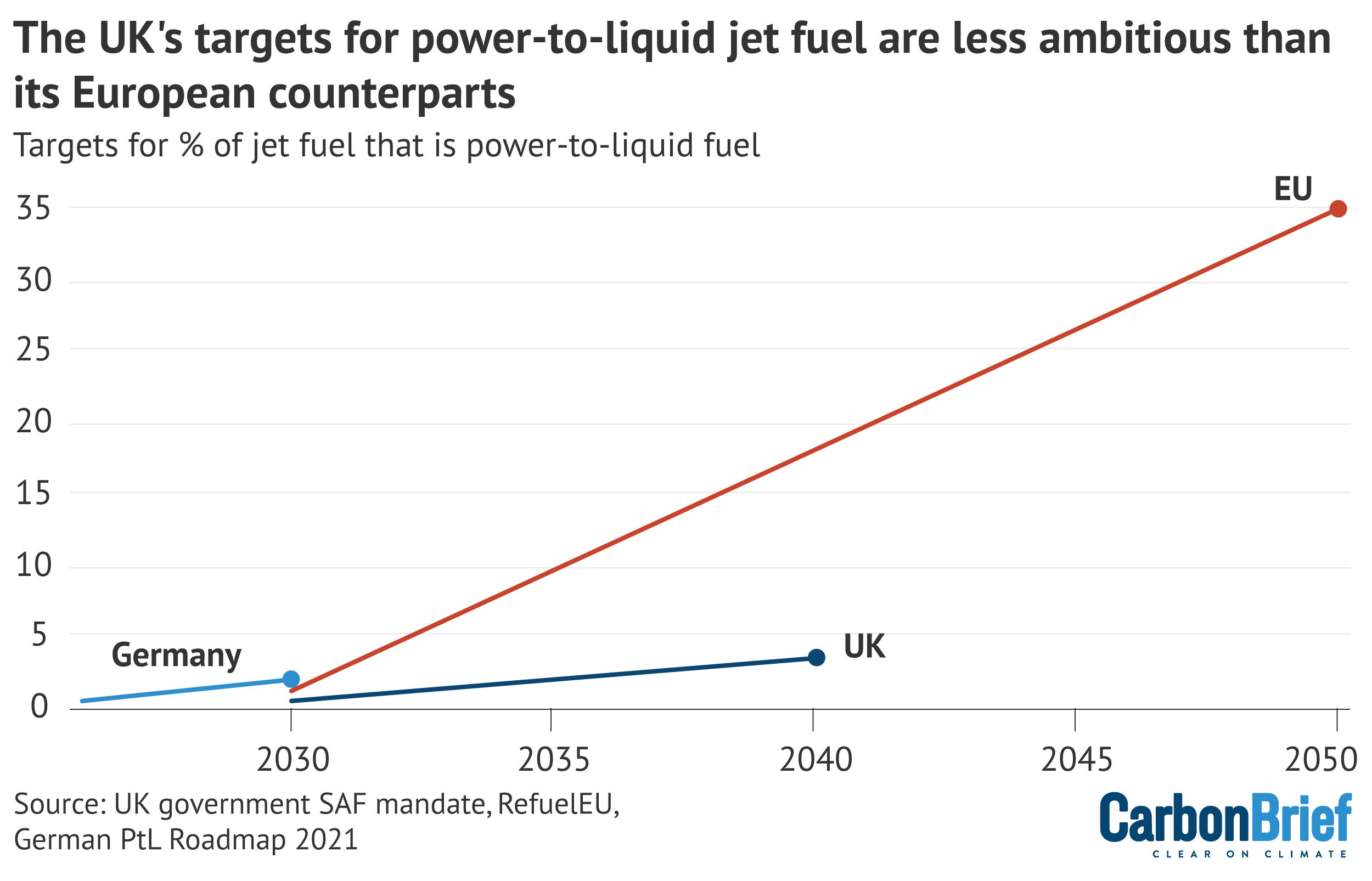UK government targets for “sustainable aviation fuels” (SAFs) will only cut emissions from the sector to 0.8% below current levels in 2040, Carbon Brief analysis shows.
From 2025, flights taking off from the UK must use a fixed share of SAFs, which are largely made from waste products. This share will gradually rise from 2% next year to 22% in 2040.
The government says its “SAF mandate” will cut aviation emissions by 6.3m tonnes of carbon dioxide equivalent (MtCO2e) in 2040.
However, Carbon Brief analysis of government forecasts shows this being almost entirely wiped out by rising demand for air travel, meaning emissions would only fall by 0.8% overall.
The SAF mandate is the most substantial policy to date under the UK government’s “jet-zero” strategy for decarbonising air travel, which eschewed efforts to limit demand. The mandate relies heavily on fuels made from used cooking oil and other waste products, which are in limited supply.
No change
The SAF mandate will require jet fuel suppliers to ensure that an increasing share of the product they supply is “sustainable”. This is meant to encourage investment in new facilities to produce SAFs.
Fuels described as SAFs include those made from waste, such as used cooking oil, household waste and offcuts from the forestry sector.
Despite their name, SAFs produce just as many emissions as fossil fuels when burned to power planes.
However, they generally – although not always – have a lower overall “lifecycle” carbon footprint than petroleum-based jet fuel. This is due to CO2 emissions absorbed from the atmosphere when growing plants for biofuels, or emissions that are avoided by diverting waste products to be used as fuels.
These emissions savings are counted towards the UK’s aviation sector as a whole.
(The government says that, for the time being, it will not support SAFs made directly from crops, which tend to have relatively high carbon footprints due to changes in land use.)
The new UK mandate starts in 2025 with a requirement that 2% of total jet fuel demand is SAF, increasing to 10% in 2030 and 22% in 2040. The government says there is currently not enough certainty in the SAF market to set targets beyond that date.
These measures will cut overall aviation emissions by 2.7MtCO2e in 2030 and 6.3MtCO2e in 2040, according to the government.
Based on government forecasts for jet fuel use, this change will be almost totally offset by a growth in flights, leaving UK aviation emissions virtually unchanged between now and 2040.
Emissions in 2025 are expected to be 36.0MtCO2e, while 15 years later they are set to be 35.7MtCO2e, according to Carbon Brief analysis. This is a drop of just 0.3MtCO2e, or 0.8%. This is illustrated in the chart below, with the SAF mandate merely preventing an increase in emissions resulting from higher jet fuel use in 2040.
These figures are derived from the government’s “central case”, cited in its underlying analysis for the SAF mandate, which sees jet fuel use increasing from 11.5m tonnes (Mt) in 2025 to 13.3Mt in 2040. This, in turn, is based on policies in the government’s “continuation of current trends” scenario, with the SAF mandate included.
The government expects far more flights to take off from the UK in the coming years, resulting in higher jet fuel use. It has resisted pressure to curb the demand for air travel, despite warnings from experts that such actions are vital for reducing aviation emissions.
In its jet-zero strategy, the government stated that it is aiming for a “high ambition” scenario, which would see aviation emissions fall faster in the coming years. However, as it stands, it has not introduced policies to drive further emissions reductions in planes.
The SAF mandate assumes that SAFs reduce lifecycle emissions from jet fuel by 70%. Certificates will be issued to fuel suppliers for each tonne of SAF produced, using this baseline emissions reduction goal as the standard.
However, Prof Bill Rutherford, an Imperial College London biochemist who contributed to two major assessments of low-carbon aviation fuels in the UK last year, tells Carbon Brief he is sceptical about lifecycle emissions analysis that shows such high emissions benefits:
“Lifecycle analysis is a very fuzzy science…You can basically get what you want out of it.”
For example, in its analysis, the government assumes that SAFs made from used cooking oil – which are expected to make up virtually the entire UK supply in the short-term – cut lifecycle emissions by roughly 95-98% compared to conventional jet fuel.
Dr Andrea Fantuzzi, another Imperial College London chemist who also worked on the low-carbon fuel assessments with Rutherford, says such figures seem “way too high”. He estimates that the savings would be closer to 70%.
Fantuzzi adds that even this does not account for the land originally used to produce the oil, and assumes that the oil would otherwise be thrown away – rather than used to power road vehicles, for example. (For more on waste oils, see: More cooking oil.)
Additionally, Rutherford points out that the use of SAFs has no impact on non-CO2 emissions from planes, which could account for up to two-thirds of their climate impact. He concludes:
“The only way you can make aviation any more sustainable is to do less of it.”
More cooking oil
The only SAFs that are currently available in the UK are fuels made from used cooking oil and other waste oils, which are collected from restaurants and factories.
However, the SAF mandate includes a limit on the amount of waste oil-based fuels within its overall targets. This is partly to “incentivise the development of new technologies” and partly due to concerns that waste oil supplies will be insufficient.
For the first two years, these fuels will be allowed to make up 100% of UK SAFs. This then falls to 71% in 2030 and 33% in 2040. Overall, waste oil-based SAFs would account for 2% of total jet fuel use in 2025 and up to 7.8% in 2040.
Despite these limits, waste oil-based SAF use is expected to rise around 15-fold from current levels within a decade. This huge increase in demand for waste cooking oil under the SAF mandate is illustrated in the figure below.

The Aviation Environment Federation said in a statement that the amount of waste oil being allowed into UK jet fuel under the UK’s SAF mandate is “much higher than we, and many others, were expecting, and appears to be the result of airline pressure”. The looser cap on these fuels was “welcomed” by industry body Airlines UK.
It raises the question of where the UK will source the required volume of waste oil to meet SAF targets.
Studies have shown that there is nowhere near enough waste cooking oil produced domestically, within the UK, to supply jet fuel demand. “We’re not about to start eating more chips, so we will have to start importing more waste oil,” Matt Finch, UK policy manager at the NGO Transport and Environment, tells Carbon Brief.
The government itself acknowledges this, saying that production of these SAFs within the UK is likely to be constrained by the availability of waste cooking oil from 2029 onwards.
It notes that their availability will therefore be “highly dependent” on how much waste oil the UK can import.
As of 2023, waste cooking oil collected in the UK only accounted for 7% of the country’s SAF production. This share has shrunk in recent years, such that imports from other countries – particularly China – have driven most of the growth in production, as the chart below shows.

There is mounting evidence that the demand for imported cooking oil in the UK and Europe is being met with virgin palm oil that has been fraudulently passed off as waste. This would cancel out the fuel’s emissions savings, due to the land clearances for oil palm plantations.
The UK’s aviation sector will have to compete not only with other countries for a limited pool of waste cooking oil, but also with other sectors.
Most of the UK’s waste cooking oil supplies are currently used to make biofuels for trucks and other road transport. Again, diverting resources from road fuel use would undermine the emissions savings from using them in SAFs.
The government acknowledges this, noting that “the SAF mandate may divert feedstocks which would have been utilised in other sectors of the economy and this may increase emissions in other sectors”. However, it says this is justified because “there are limited alternatives to decarbonise aviation by 2050”.
One of the scenarios modelled by the government assumes that SAF targets are met, but insufficient waste cooking oil means there is not enough biodiesel for road vehicles. This reduces the cumulative emissions savings between 2025-40 from 53.9MtCO2e to 43.0MtCO2e.
New fuels
The government is also supporting new types of SAF production in the UK, including fuels made from “black bin bag waste” and residues from farming or forestry.
In the newly released documents, the government says the UK will be a “leader” and a “first mover” in these technologies, spurred on by the cap on waste oil fuels and supported by the Advanced Fuel Fund.
Unlike waste oil-based fuels, the government says there will be “sufficient” materials available to meet production demand for these advanced fuels until at least 2040. From that point onwards, it says lack of materials “may become a constraining factor”.
However, a 2023 report by the Royal Society highlighted the limited availability of some waste materials to produce SAFs. It estimated that forest offcuts, for example, would be able to provide no more than 1.7% of current jet fuel demand.
Moreover, many waste sources are already recycled or burned to generate electricity and the government has targets in place to cut household waste in the coming years. “Most waste is already used for something that’s not jet fuel, so we know supplies of waste-based SAF will be limited,” Finch tells Carbon Brief.
Finally, the government’s mandate also includes another target, within the overarching SAF goal, for scaling up the production of “power-to-liquid” fuels.
These fuels can be made using green hydrogen and carbon captured from the air. Unlike most SAFs, they could cut up to 100% of CO2 emissions compared to conventional jet fuel, but they are currently less developed than other options.
The target for power-to-liquid fuels will start in 2028 at 0.2% of total jet fuel demand, reaching 0.5% in 2030 and 3.5% in 2040.
These targets are lower than the ones introduced in the EU, which is aiming for 35% of its jet fuel to be power-to-liquid by 2050. The bloc is also targeting 70% of aviation demand to be met with SAFs by 2050, whereas the UK’s targets stop at 22% by 2040.

In its “balanced net-zero pathway” for UK aviation, government advisors the Climate Change Committee (CCC) proposed that SAFs should make up 25% of jet fuel by 2050, with one-third of this made up of power-to-liquid fuels – roughly 8% of total jet fuel. The government targets are roughly in line with this trajectory.
Thinktank Green Alliance laid out three scenarios for SAF expansion in 2022, including higher ambition goals, with power-to-liquid fuels reaching 28% and 50% of total jet fuel by 2050.
However, it noted that such a rollout could be constrained by the large amounts of additional green hydrogen and renewable power required to produce these fuels.
The report stated:
“It could be argued that aviation should not be a priority use of renewables as there are other options to cut carbon in the sector, such as managing the number of flights taken.”
Sharelines from this story


